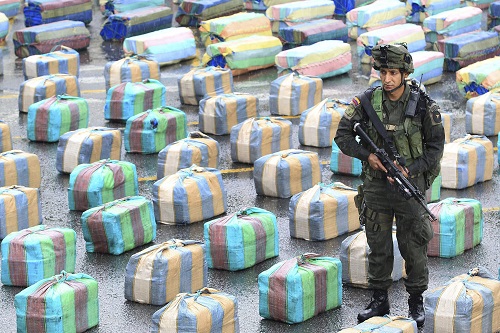Reuters photo
By
Ricardo Swire
Recent information provided by one Colombian drug cartel’s Trafficking Coordinator, aka “Juan”, suggested transnational criminal syndicates function in the shadows of legitimate Costa Rican companies. Such underworld operators are unofficially supported by rogue customs officials who sell confidential data. For every one thousand kilos of cocaine transiting the “Southern Triangle” or Colombia, Panama and Costa Rica, as much as twenty tons of cocaine is dispatched. The drugs move in maximums of one hundred kilos per cement truck and are transported by convoy to Costa Rica’s sixth largest city called Limon.
Juan’s Colombian cartel has a “contract” with a registered Costa Rican cement company that owns two hundred trucks. Such arrangement allows cocaine exports to depart Colombia’s northern coastal port of Cartagena, camouflaged among agricultural products in shipping containers en route to Limon. The drugs are forwarded to America, China and Europe. Between April 2010 and April 2016 Costa Rican counter-narcotics agents intercepted more than one hundred thousand pounds of cocaine. If a similar amount of product was allowed to enter Spain the cocaine shipment would value approximately US$7.6million.
Six years of Costa Rican intelligence surveillance records detailed five hundred and fifty-four drug shipments with “change-of-hands.” Four hundred and sixty domestic law enforcement operations detected seven hundred and two kilos of cocaine aboard arriving commercial aircrafts. Caribbean internal security intelligence officials are aware large cocaine consignments enter Costa Rica via maritime approaches and are warehoused then broken up in smaller quantities and dispatched via air, land and sea resources. Human drug mules smuggle two kilo drug packages aboard commercial airline flights that travel to six main destinations.
Some waterborne multinational traffickers prefer docking in Costa Rica to refuel and continue northward, skirting Guatemala and Mexico. Local go-fast boats are loaded launched and rendezvous either on the Caribbean or Pacific coasts to avoid radar surveillance. Merchandise shipped across the Pacific transits Boca Del Toro in Panama. Costa Rica’s Caribbean coast drug deliveries arrive from Colombia and Panama. Between 2010 and 2016 sixty-three American and European law enforcement counter-narcotics operations intercepted five thousand kilos of cocaine aboard merchant ships. The cocaine was hidden inside yuccas and pineapples destined for ports in Philadelphia USA and Rotterdam in the Netherlands.
Law enforcers captured one Cuban and six Costa Rican traffickers attempting to deliver illegal product to the Italian mafia. Two Cuban and three Costa Rican informal exporters, who smuggled cocaine wrapped in carbon paper via legitimate domestic companies, were also uncovered. Between 2010 and 2015 an increase of cocaine packages sent by Costa Rican traffickers via surface mail was observed. From 2014 to 2016 fourteen joint Costa Rican/Colombian law enforcement counter-narcotics operations confiscated eleven point seven six kilos of cocaine transiting Costa Rica’s territorial waters. The drugs were transported in four containers of pineapples from the Port of Moin, on Costa Rica’s Atlantic coast, to the Dutch port of Rotterdam.
Ricardo Swire
Ricardo Swire is the Principal Consultant at R-L-H Security Consultants & Business Support Services and writes on a number of important issues.



No Comments Yet!
You can be first to comment this post!